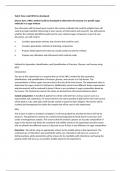Essay
applied science - unit 19 c part 3 and part 4 (section 1 ) - chemistry - distinction level
- Course
- Institution
Task3: How could HPLC be developed. Discuss how a HPLC method could be developed to determine the amount of a specific sugar molecule in a sugar mixture Task 4: How to optimize separation.
[Show more]



